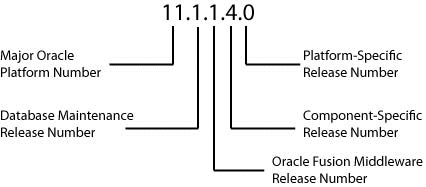| Oracle® Fusion Middleware Administrator's Guide 11g Release 1 (11.1.1) Part Number E10105-11 |
|
|
PDF · Mobi · ePub |
| Oracle® Fusion Middleware Administrator's Guide 11g Release 1 (11.1.1) Part Number E10105-11 |
|
|
PDF · Mobi · ePub |
This appendix describes how to view Oracle Fusion Middleware release numbers.
This appendix contains the following topics:
To understand the release level nomenclature used by Oracle, examine the example of an Oracle Fusion Middleware release number shown in Figure G-1.
Figure G-1 Example of an Oracle Fusion Middleware Release Number

In Figure G-1, each digit is labeled:
Major Oracle platform number
This is the most general identifier. It represents a major new edition (or version) of an application, such as Oracle database server or Oracle Fusion Middleware, and indicates that the release contains significant new functionality.
Database maintenance release number
This digit represents a maintenance release level. Some new features may also be included.
Oracle Fusion Middleware release number
This digit reflects the release level of Oracle Fusion Middleware.
Component-specific release number
This digit identifies a release level specific to a component. Different components can have different numbers in this position depending upon, for example, component patch sets or interim releases.
Platform-specific release number
This digit identifies a platform-specific release.
The following sections describe how to obtain the release numbers of Oracle Fusion Middleware:
All Oracle Fusion Middleware installations have a release number. This number is updated when you apply a patch set release or upgrade the installation.
You can view the release number of an Oracle Fusion Middleware installation using Oracle Universal Installer, as follows:
Launch Oracle Universal Installer:
(UNIX) ORACLE_HOME/oui/bin/runInstaller.sh (Windows) ORACLE_HOME\oui\bin\setup.exe
Click Installed Products to open the Inventory Page.
In the Inventory Page, expand Oracle Homes. The entries for all installations on your host are displayed.
Expand the Oracle home entry for the installation you are interested in.
An entry with the release number for your original installation, followed by entries for any patch sets that have been applied, are displayed.
All Oracle Fusion Middleware components have a release number and many contain services that have release numbers. These numbers may be updated when you apply a patch set release or upgrade the installation.
You can view the release number of components and their services in the following ways:
On the File System
You can view component release numbers as follows on UNIX:
cd ORACLE_HOME/inventory
ls -d Components*/*/*
Using Oracle Universal Installer
If you installed Oracle Fusion Middleware using Oracle Universal Installer, you can view component release numbers as follows:
Launch Oracle Universal Installer:
(UNIX) ORACLE_HOME/oui/bin/runInstaller.sh (Windows) ORACLE_HOME\oui\bin\setup.exe
Click Installed Products to open the Inventory Page.
In the Inventory Page, expand Oracle Homes. Entries for all installations on your host are displayed.
Expand the Oracle home entry for the installation you are interested in.
An entry with the release number for your original installation, followed by entries for any patch sets that have been applied, are displayed.
Expand the initial entry to view the component release numbers at installation time. If you have subsequent patch set entries, expand them to see the component release numbers updated for each patch set.
Oracle Internet Directory has a server release number, which is the version of the binaries. It also has schema and context versions. All of these numbers correspond to the Oracle Fusion Middleware installation release number through the third digit. These numbers may be updated when you apply a patch set release or upgrade the installation.
Viewing the Oracle Internet Directory Server Release Number
The Oracle Internet Directory server release number is the version of the binaries. You can view the Oracle Internet Directory server release number as follows:
Ensure that the ORACLE_HOME environment variable is set.
Run the following command:
(UNIX) ORACLE_HOME/bin/oidldapd -version (Windows) ORACLE_HOME\bin\oidldapd -version
Viewing the Oracle Internet Directory Schema and Context Versions
You can view the Oracle Internet Directory schema and context versions in this file:
(UNIX) ORACLE_HOME/ldap/schema/versions.txt (Windows) ORACLE_HOME\ldap\schema\versions.txt
The contents of this file are kept up-to-date, however, you can also query the schema and context release from Oracle Internet Directory, just to be sure.
To view the schema version:
Ensure that the ORACLE_HOME environment variable is set.
Run the following command:
ldapsearch -h oid_host -p oid_port -D "cn=orcladmin" -q -b "cn=base,cn=oracleschemaversion" -s base "objectclass=*" orclproductversion
Because you use the -q option, the command prompts you for your password.
The output is in this form:
cn=BASE,cn=OracleSchemaVersion orclproductversion=90500
To view the context version:
Ensure that the ORACLE_HOME environment variable is set.
Run the following command:
ldapsearch -h oid_host -p oid_port -D "cn=orcladmin" -q -b "cn=oraclecontext" -s base "objectclass=*" orclversion
Because you use the -q option, the command prompts you for your password.
The output is in this form:
cn=oraclecontext orclversion=101200
The Metadata Repository is an Oracle Database database that has a release number. This number is updated when you apply a patch set release or upgrade the database.
You can view the Metadata Repository release number using SQL*Plus as follows (you can be connected to the database as any user to issue these commands):
SQL> COL PRODUCT FORMAT A40 SQL> COL VERSION FORMAT A15 SQL> COL STATUS FORMAT A15 SQL> SELECT * FROM PRODUCT_COMPONENT_VERSION; PRODUCT VERSION STATUS ---------------------------------- -------------- ---------------- NLSRTL 11.2.0.1.0 Production Oracle Database 11g Enterprise Edition 11.2.0.1.0 Production PL/SQL 11.2.0.1.0 Production TNS for Linux: 11.2.0.1.0 Production